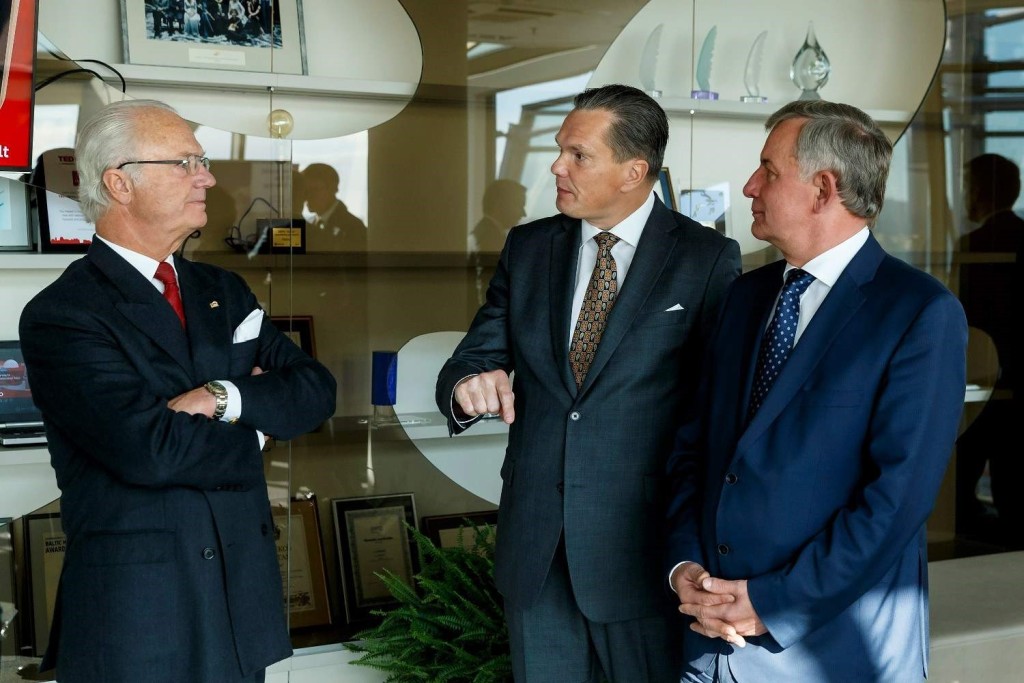
THE VOICE OF INTERNATIONAL LITHUANIA
|
VilNews has its own Google archive! Type a word in the above search box to find any article.
You can also follow us on Facebook. We have two different pages. Click to open and join.
|

By Eitvydas Bajarūnas
Lithuanian Ambassador to Sweden
My answer to affirmative “yes”. Yes, Lithuanian ties across the Baltic Sea become as never before solid in recent years. For me the biggest achievement of Lithuania in the Baltic Sea region during recent years is boosting Baltic and Nordic ties. And not because of mere accident – Nordic direction was Lithuania’s strategic choice.
The two decades that have passed since regaining Lithuania‘s independence can be described as a “building boom”. From the wreckage of a captive Soviet republic, a generation of Lithuanians have built a modern European state, and are now helping construct a Nordic-Baltic community replete with institutions intended to promote political coordination and foster a trans-Baltic regional identity. Indeed, a “Nordic-Baltic community” – I will explain later in my text the meaning of this catch-phrase.
Since the restoration of Lithuania’s independence 25 years ago, we have continuously felt a strong support from Nordic countries. Nordics in particular were among the countries supporting Lithuania’s and Baltic States’ striving towards independence. Take example of Iceland, country which recognized Lithuania in February of 1991, well in advance of other countries. Yet another example – Swedish Ambassador was the first ambassador accredited to Lithuania in 1991. The other countries followed suit. When we restored our statehood, Nordic Countries became champions in promoting Baltic integration into Euro-Atlantic institutions. To large degree thanks Nordic Countries, massive transformations occurred in Lithuania since then, Lithuania became fully-fledged member of the EU and NATO, and we joined the Eurozone on 1 January 2015.
Lithuania took advantage of it very successfully because we soon realized that the assistance and support of the Nordic Countries could help us to play more a significant role in the European and transatlantic space as well as help us solve problems that were urgent for us and the entire region. Nordics, especially – Sweden, became the largest investors in Lithuania, not to mention their financial support for our states’ civil societies, democracy and other important processes which were particularly important to us as developing states that had restored their independence and statehood. And this is quite natural: Nordic and Baltic are united by common values, interests and clear goals. We cherish our freedom but we also care a great deal about everyone’s right to be free.
Several public opinion polls pointed out that Lithuanians believe Lithuania should be associated with the region of Northern Europe, and not with Eastern Europe. Northern orientation dominated in the cases of Estonia and Latvia as well. Orientation towards the North was even proposed by a foreign company that consulted the Government of Lithuania some years ago on image creation issues: in terms of economy Lithuania had rather be associated with the stable, advanced, socially responsible Nordic Countries than the post-soviet space.
Indeed, Lithuania benefits being part of the wider Nordic-Baltic region. Over the last several decades, the Nordic-Baltic region has most probably undergone the greatest transformation. Lithuania developed into a country, associated with economic and fiscal stability, high-level political integration, advanced technologies and high living standards. Extensive and broad cooperation between the countries in the region played a crucial role. The idea that the countries of the region are competitive and economically stable has also been proved by the fact that Nordic Countries have been only slightly affected by the economic and financial crisis that began in 2008, and Baltic States have quite successfully curbed the effects of it. In the past two decades Baltic and Nordic countries have got closer and closer. We are developing an intense political dialogue, mutually beneficial contacts in trade, science and education, and people-to-people contacts.
The Nordic Baltic Eight (NB8, for short) – consisting of Denmark, Estonia, Iceland, Finland, Latvia, Lithuania, Norway and Sweden – has become a political institution that mirrors the emerging trans-Baltic regional identity. Under the NB8 umbrella, meetings on the ministerial level are now held on a regular basis. Within the European Union context, Nordic and Baltic leaders often coordinate their positions ahead of key debates and decisions. Nordic-Baltic region is becoming like a family of some of the most politically stable, economically sustainable and competitive countries in the world. The region is also increasingly known internationally as an area of innovation and information technology, and together our eight countries represent the 5th economy within EU and the 11th largest economy in the world.
Therefore we can talk with a confidence of a “Nordic-Baltic” community, or as the pre-war Lithuanian scientist Kazys Pakštas named it, the “Baltic-Scandic” community. One could only asks – why are the businesses of Nordic Countries so easily and effectively establishing and expanding in the Baltic States? It has solid foundations – the business community finds plenty of common ground and similarities in both the culture of work and the understanding of business. That’s why Nordic business is willingly investing in Lithuania. And Lithuanians are contributing to Norwegian, Swedish, Danish growth by starting companies and joining their labor market. Lithuania and the other Baltic states treated the financial/economic crisis that began in 2008 and lasted in 2009–2010 in a “Nordic” way – they did not rush to keep on borrowing thus attempting to retain economic prosperity and consumption, but were cutting expenses, instead, thus “tightened their belts” and forced the economies to operate again through economic measures (sometimes drastic ones). By this quality Lithuanians demonstrated that we belong to Northern Europe (despite the fact that most Lithuanians are Catholic and are sometimes referred to in jest by Estonians as the “Italians of the Baltic”).
Recently Lithuania was hosting State visit of Swedish Royal couple. It was symbolic that the main theme of Their Majesties’ visit to Lithuania was “The Baltic Sea unites us”. The sea which used to separate Nordic and Baltic people is now uniting us through numerous political, energy, cultural, research, business, and people-to-people ties. Indeed, we Nordics and Baltics are bound by common values, traditions and culture. The Midsummer celebration – known as Joninės in Lithuania – is the best proof of this. It has become a much-awaited community event in Lithuania, just like in other Nordic and Baltic states, highlighting the strong links between our nations.
But we not only remembering our past, but most importantly looking to the future. The Swedish-Lithuanian NordBalt undersea power bridge – scheduled for operation at the end of this year – will become yet another link connecting Nordic and Baltic countries, and will allow Lithuania and other Baltics to have secure and competitive energy supplies, reducing our historic dependence on Russia for our energy needs.
True, the Baltic States still have to emulate Nordic countries, which amaze the world by being at the very top of the “Human Development” index and have not been surpassed in terms of living standard. Nordic Countries are one of the most successful regions of the world when estimating not only the quality of living but also the social environment and work culture. Nordic Countries are also leading countries in the field of innovation, high sustainability and advanced ecological standards, countries striving to be the most gender-equal and egalitarian in the world, with a cohesive and solidarity-based society. It is inspiring and motivating. Lithuanians are well known for their creativity and diligence, but still a lot to learn from our Nordic partners. We believe that the Nordic socio-economic model is something Lithuania should aspire to, and that much can be borrowed and beneficially transported across the Baltic. Yet there remains a significant lack of cultural and societal awareness between Lithuania and Nordics that must be overcome.
While much remains to be accomplished, the remarkable achievements of the past twenty years are a testament that Nordic-Baltic region moving to the right direction. Wish us good luck.

AMBASSADOR EITVYDAS BAJARŪNAS WITH THE SWEDISH KING CARL XVI GUSTAF
- Bookmark :
- Digg
- del.icio.us
- Stumbleupon
- Redit it
VilNews e-magazine is published in Vilnius, Lithuania. Editor-in-Chief: Mr. Aage Myhre. Inquires to the editors: editor@VilNews.com.
Code of Ethics: See Section 2 – about VilNews. VilNews is not responsible for content on external links/web pages.
HOW TO ADVERTISE IN VILNEWS.
All content is copyrighted © 2011. UAB ‘VilNews’.

 Click on the buttons to open and read each of VilNews' 18 sub-sections
Click on the buttons to open and read each of VilNews' 18 sub-sections 


